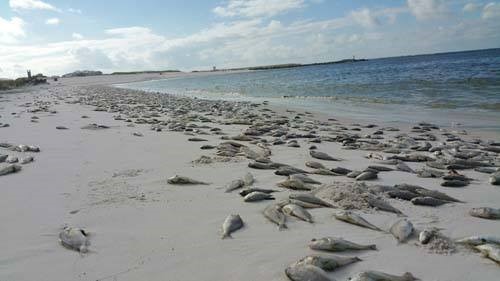
by Rick O'Connor | Oct 31, 2015
Many coastal Panhandlers woke up this week to the sight and smell of dead fish. Thousands of them washed ashore from Panama City to Pensacola. This mass die off included a variety of species including whiting, sheepshead, hake, cusk eels, and even lionfish; there were also reports of dead bass from the Dune Lakes in Walton and Okaloosa counties. What caused this mass die off of fish?
The suspect is red tide…
Most of us along the panhandle have heard of red tide but we may not know what it is or what causes it. Many attribute the red tide events to human impacts, stormwater runoff etc., but in fact they have been around for centuries. There are records suggesting that the European colonials experienced them and I have read one account that the Red Sea got its name from the frequency of these events there. So what is this “red tide” and what causes it?
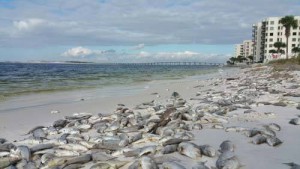
Dead fish line the beaches of Panama City.
Photo: Randy Robinson
It is actually a bloom of small single celled plants called dinoflagellates. There are thousands of species of dinoflagellates in the world’s oceans and not all cause red tide, but there are several species that do. These small microscopic plants drift near the surface of the ocean acquiring sunlight to photosynthesize. They possess two small “hairs” called flagella (hence the name “dinoflagellate”) to help orient themselves in the water column. Most have a shell covering their body called a theca and some shells have small spines to increase their surface area to resist sinking. One method of defense found in some dinoflagellates is the production of light – bioluminescence. This light is produced by a chemical reaction triggered by the creature as a flash of blue – many locals refer to it as “phosphorus”. Other dinoflagellates instead will release a toxin… some of these are ones we call “red tide”.
Red tide organisms are always in the water column of marine environments but are usually in low concentrations, maybe 300-500 cells per milliliter of water. But under favorable conditions, warm water with nutrients, they multiple… sometimes in great numbers, such as 3000-5000 cells/ml, and we have a “bloom”. The number of cells within these blooms can be high enough that we can actually see the water change color… hence “red tide”.
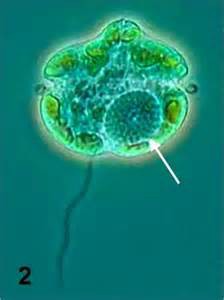
The dinoflagellate Karenia brevis.
Photo: Smithsonian Marine Station-Ft. Pierce FL
The most common red tide dinoflagellate associated with the Gulf of Mexico is Karenia brevis. Karenia blooms typically form offshore and are of little impact to the coastal communities. However when the wind and tides are right these blooms will drift towards shore. When they do fish kills occur and humans have eye and throat irritations. Marine mammals in particular struggle with red tide. As the bloom comes near shore it reaches the bottom of the water column and many of the bottom dwelling fish suffer. Most of the photos of fish I saw in the October 2015 fish kill were bottom dwellers, including many invasive lionfish.
Is there anything we can do to prevent red tides?
Not really… Again, they are naturally occurring event. We may increase the frequency of the events by discharging excessive nutrients into the water from our run-off but they would probably occur anyway. Red tide events are not as common in the panhandle as they are in southwest Florida. The Gulf waters near Charlotte Harbor are shallow, warm, and near the many manicured lawns, gold courses, and the discharge of much of the agriculture in the state. Occasionally blooms formed in that part of the state drift north but this year a bloom formed off of Bay and Gulf counties in early October. The recent storm that passed through probably pushed the bloom inland and to the west. The biggest hazard of humans is eye, throat, and skin irritation. It is quite uncomfortable to be around these blooms. In 1996 a local bloom was concentrated enough that the campground at Ft. Pickens had to be closed. I was in Galveston Texas when I heard about the red tide occurring in the Florida panhandle. As I was leaving Galveston the newspaper reported the closer of all oyster harvesting in Texas due to a red tide generated in the Padre Island area and was moving north. Seems that red tide is covering a large portion of the Gulf coast the last week of October. That said… anything communities can do to reduce nutrient runoff will certain decrease the frequency of red tides.
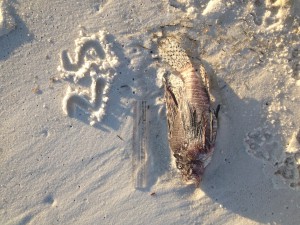
The carcass of the invasive lionfish was part of the October red tide kill.
Photo: Shelly Marshall
The Florida Fish and Wildlife Conservation Commission post red tide updates from around the state on their website and the Escambia County Extension Office post a local water quality update each Friday that has red tide information as well.
FWC
http://myfwc.com/research/redtide/
Escambia County Extension
http://escambia.ifas.ufl.edu
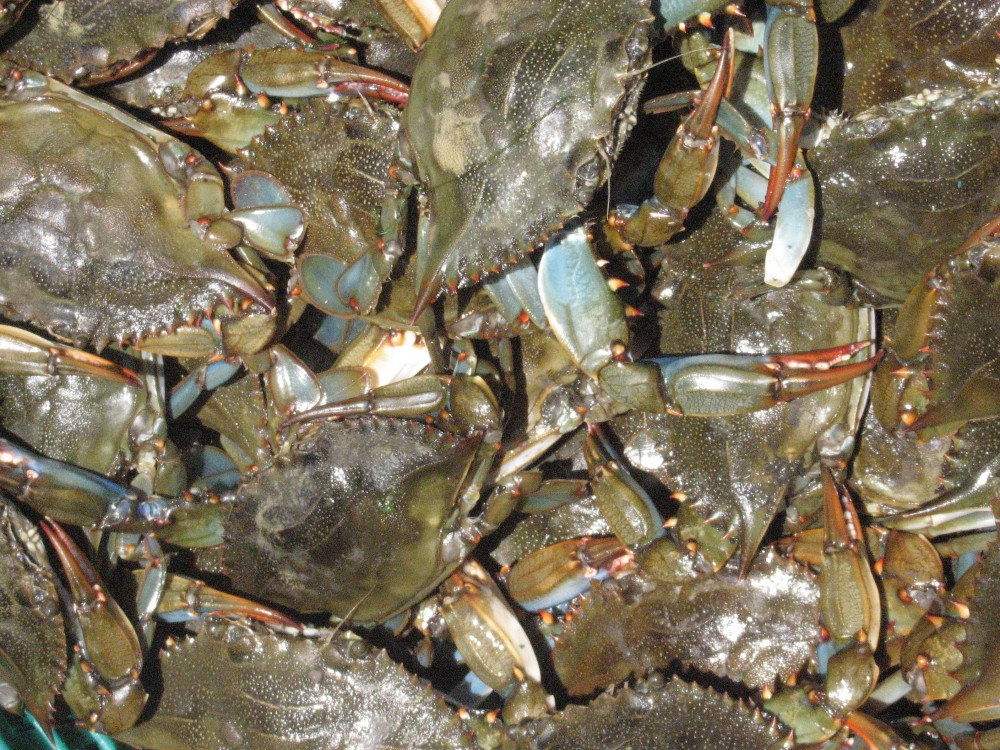
by Rick O'Connor | Oct 23, 2015
Well… we have talked about the “big two”… snapper and shrimp, but there are other popular fin and shellfish harvested from the Gulf of Mexico. This week we look at my personal favorite… blue crab.
Probably like many of you out there, the very first sea creature I ever caught was a blue crab. It was with one of those classic basket traps where you baited it, lowered to the bottom where you could see, waited until a crab came for the bait, and pulled her in… GREAT fun. My parents cooked the crab, saved the shell and dated it. It sat on the cabinet above our breakfast bar for years. It was something I did every summer off the dock of the house we rented on Pensacola Beach… good times.
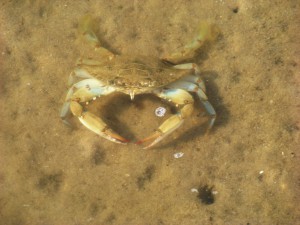
The thin telson beneath this crab indicates it is a male.
Photo: FWC
As I got older we switched from crab traps to hand-held crab nets. We would spend hours searching the grass beds around Gulf Breeze collecting and cleaning these guys. I remember cleaning over 60 of them once until my hands bled, that was about the time I thought I would let the commercial guys do this and I would just buy it from them!
As much fun as I had catching them, I had just as much fun cooking. My wife and I would make deviled crab and one of my personal favorites of hers, crab meat baked on an English muffin with cheese. Man o’ man. What a great creature the crab.
There are about 4500 species of “true crabs” found on our planet and many are valuable as a seafood product. In the Florida Panhandle it is the Blue Crab most seek out. In recent years commercial and recreational crabbers have noticed a decline in their numbers. Landings of blue crab ranged between 8 and 12 million pounds in Florida from 1982-1999 and since 2000 the landings have ranged from 4 to 8 million pounds. Researchers with the Florida Fish and Wildlife Conservation Commission have run several models to determine why the decline in landings has occurred. Though the decline in the Chesapeake may be due to overfishing, the models do not suggest this for Florida. They are not sure why the decline has happened but do have data that support the argument that freshwater discharge during heavy rain events does impact their population in a negative way. Some data suggest the increase in salinity during drought conditions has done the same. Whatever the reason, many would like to see their numbers rebound to the 12 million lb. landings we had just a few years ago.
Blue crabs typically live to be 1-2 years old, though some have been aged to 5 years. Males prefer the less saline waters of the upper estuary and the females can be found throughout the bay. Males reproduce more than once in their lives providing the females with a sack of sperm called a spermatophore. Females mate only once, just after their last molt. Once she has received the spermatophore she heads for the mouth of the bay where the water is more saline, she may enter the Gulf of Mexico searching for the right habitat. When she fertilizers her eggs they remain with her as a mass on her underside; the egg mass resembles a sponge. The larva hatch from this mass and go through several development stages as they re-enter the estuary and begin the cycle again.
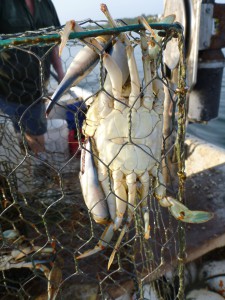
Whatever the reason for their decline, and recent increase in price, these crustaceans remain a Gulf coast favorite and I for one hope they remain around for a long time.

by Rick O'Connor | Oct 17, 2015
If shrimp are king of the shellfish industry, then red snapper are the king of the finfish world. It is arguably the most economically and ecologically important reef fish in the Gulf of Mexico. This fishery began in 1872 with four “snapper smacks” out of Pensacola. By 1890 the fleet had grown to 34 vessels and had extended to other panhandle ports as well as Mobile, AL. They fished local waters for the most part but began to harvest from Campeche MX, where the fish gets its scientific name Lutjanus campechanus. By 1910 the majority of the catch was coming from the Campeche Banks, but by the 1930’s the focus of the fishery was again in U.S. waters. By the mid 20th century a steady decrease in landings began to occur and today the fishery is considered overfished.
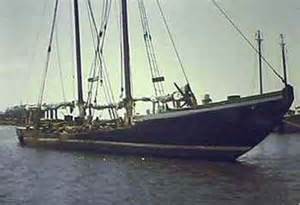
A snapper smack from the 19th century.
Photo: Brown Marine Pensacola
So what do we know about this “king of finfish”? Well, red snapper begin their lives like most fish, as planktonic larva. The larva first appear in northern Gulf around May and are found through November, with numbers peaking from July through September. Though they settle out from the plankton near hard structure, muddy bottom habitats appear to be very important as foraging grounds. Red snapper seem to stay close the hard structures they settle out near, though some movement does occur, particularly with snapper living deeper than 120 feet. They feed on zooplankton when they are young and move to a diet of small reef fish and crustaceans as adults; mantis shrimp are a particular favorite. Red snapper have been reported to live all most 50 years.
The problems with the fishery began in the mid 20th century. Though snapper were listed as overfished by the National Marine Fisheries Service their problems go beyond just overfishing. By-catch in shrimp trawls is a particular problem. Much research and money have been spent to solve this problem. Science has found that young snapper, typically caught in trawls, do not like bright light and experimental trawls with LED lighting have been tested; studies continue.
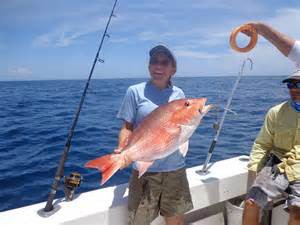
The king of finfish… the red snapper
Photo: Florida Sea Grant
In 1976 the Magnuson-Stevens Fisheries Conservation and Management Act was passed. By 1984 the first size and bag limits were issued and by 1988 the fishery was officially listed as overfished. Success at increasing numbers with the size and bag limits was low due to the shrimping by-catch issue and because many were not surviving the catch and release methods being used to return undersized fish. Studies show that snapper captured at depth experienced pressure problems as they are reeled to the service. This drastic change in pressure caused their swim bladders to expand, or rupture, a process known as barotrauma. Undersized (or over limit) fish had to be released. Those experiencing barotrauma were not surviving. Their expanded swim bladders would cause some to float – typically called “floaters” – and they were easy targets for sharks and dolphins. Others may descend slowly or reach the bottom but are still under stress and, again, were easy targets. Others still survived the release only to have issues with growth and immune function. Several techniques are used by fishing to reduce barotrauma, such as venting, but their success is debated and is currently under study.

One of the many version of descending devices used by fishermen to return snapper to depth.
Photo: Florida Sea Grant
Despite management plans the fishery is still considered overfished. Solving the problem will require plans to deal with the by-catch and barotrauma issues but will also have to address the socio-economic issues of the management itself. Many families depend on this fishery for their livelihood and though a complete ban on the species for a period of time may be beneficial to the fish stock, it may not be practical. Researchers, fisheries managers, and others will continue to work on solving this problem and hopefully the “king of finfish” will be with us for a long time.

by Carrie Stevenson | Oct 9, 2015
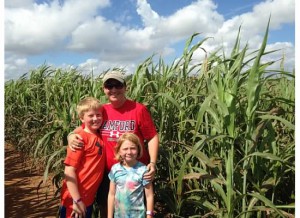
Corn and sorghum mazes are great family fun in October. Photo credit: Carrie Stevenson
October is a glorious time of year in northwest Florida. Temperatures are cooler, skies seem bluer, and the summer crowds have left the still-warm waters of the Gulf mostly to us locals. It is also the perfect time to explore the many local, state, and national parks nearby, or visit farms that share their harvest with the community. Santa Rosa County’s “Beaches to Woodlands” tour, now in its 12th year, is a perfect example of the many events and opportunities available to residents in our area. A schedule of 40 places and events over the next month can be found at the Beaches to Woodlands website.

As the summer heat fades, the weather is great for hiking! Photo credit: Abbie Seales
Escambia County will also host its annual Farm Tour this month, which highlights local growers of peanuts, cotton, and forestry. There are still spots available for this day-long tour of north Escambia County available online.
The newly released Naturally EscaRosa smartphone app, available free for iPhones (App Store) or Android (Google Play) lists 101 locations that provide outdoor adventure for every age and interest. From corn mazes and pumpkin patches to monarch migration and water sports, many local businesses provide services and products that are perfect for celebrating autumn in Florida.
Take the time this month to get outside, visit a farm, eat some locally produced food and explore the trails and wildlife in the area. You won’t regret it!
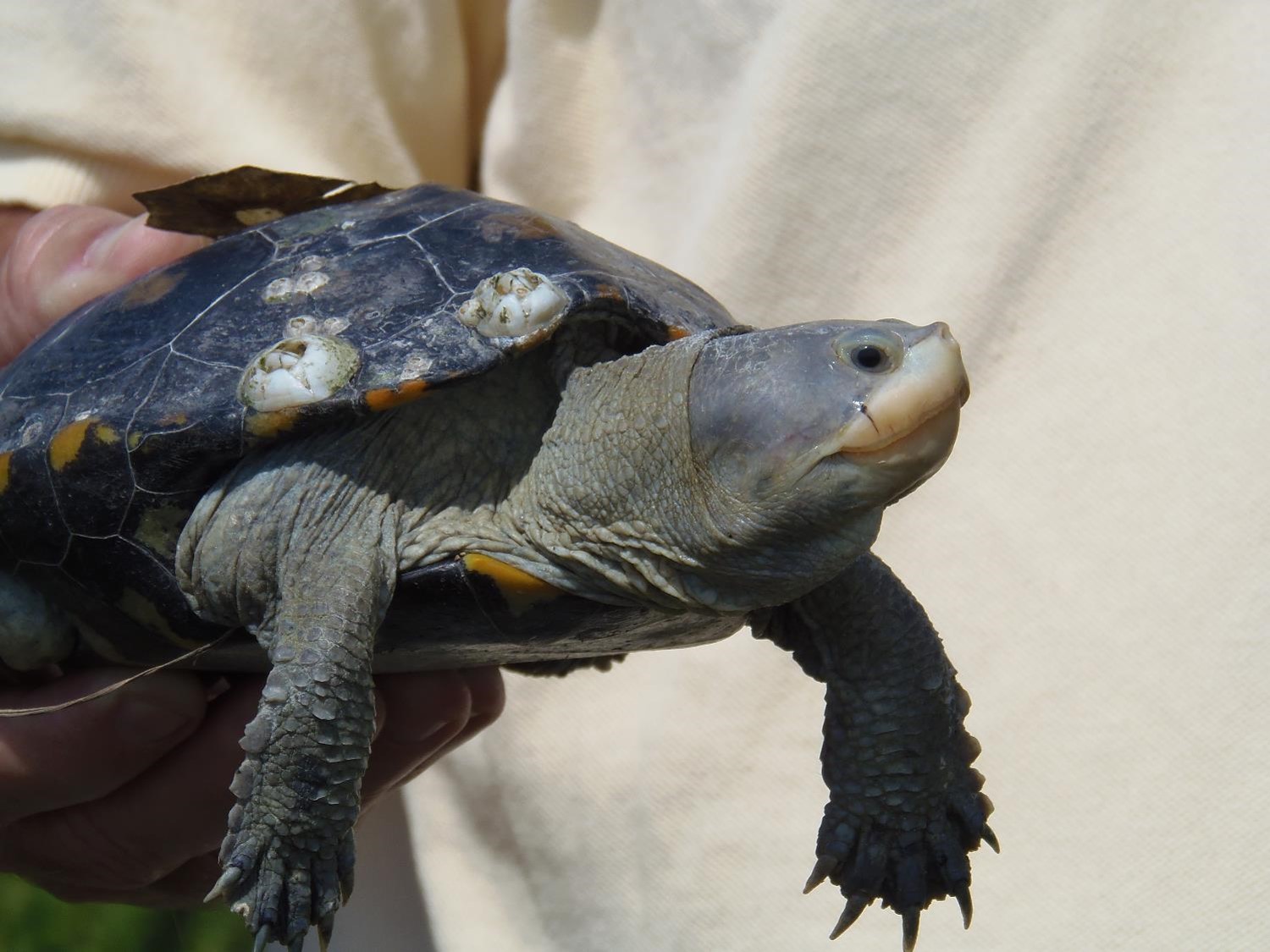
by Rick O'Connor | Oct 2, 2015
They are marvelous creatures and there are very few panhandle residents who know what they are. My wife and I were introduced to Diamondback Terrapins by George Heinrich in 2005. George was the president of a nonprofit, Florida Turtle Conservation Trust, and a member of the Diamondback Terrapin Working Group, a national group of terrapin researchers and educators. He, and these organizations, were very interested in the status of terrapins in the Florida panhandle… so Molly and I took that job on.
Diamondback terrapins (Malaclemmys terrapin) are the only true brackish water resident turtle in the United States. They range from Cape Cod MA down the entire eastern seaboard, across the Gulf of Mexico to Brownsville TX. Within that range there are 7 described subspecies, 5 of those found in Florida, 2 found in the Florida panhandle. These estuarine turtles prefer salt marsh and mangrove habitat. They are very reclusive and difficult to find – hence why most locals have never seen nor heard of them. When I talk about them to the public I get responses such as… “do you mean tarpon?” “I find those in my yard all of the time” (probably a different species), “aren’t those from up north?” and “never heard of them”… they are not fish so they could be found in your yard if you live along the fringes of a salt marsh, they are up north – but they are here also.
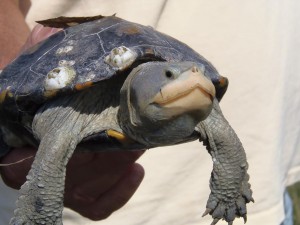
Diamondback terrapin found in Wakulla County.
Photo: Molly O’Connor
In 2005 Molly and I were asked to survey the panhandle and determine if terrapin populations still exist. We decided to take that job on and then expand to determine their population size and whether those populations are increasing or decreasing. The coastal panhandle extends from Escambia County (on the Alabama state line) to Jefferson County (Aucilla River), but due to existing funding we could only survey to the Apalachicola River. This would include six counties: Escambia, Santa Rosa, Okaloosa, Walton, Bay, and Gulf. We verified at least one record of a terrapin in each county. We discovered the larger the expanse of salt marsh – the higher probability of terrapins; thus those counties with relatively little salt marsh (such as Okaloosa) would have fewer/smaller terrapin populations.
But marsh alone is not enough. Terrapins need high ground in which to lay their eggs. High ground within a marsh is not a common thing. Research shows that terrapins will travel up to 5 miles in search of suitable nesting; which means a terrapin could be found in your neighborhood even if no marsh is visible. Unlike sea turtles they are “home-bodies” rarely leaving the marsh where they were born. They spend time forging for shellfish (particularly the snail called marsh periwinkle – Littorina irorata) and basking on and in the mud. They can be seen at the surface with their heads peering at you – they seem to be very curious.
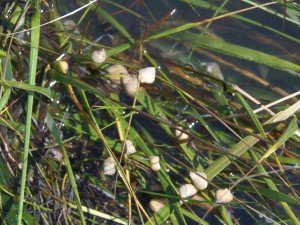
Marsh periwinkles will climb cordgrass to avoid predation by blue crabs and terrapins.
Photo: Molly O’Connor
Once we confirmed that terrapins were still in the panhandle we then began work on how many. To do this we needed to find their nesting beaches. Terrapin nesting season is about the same as that of sea turtles (May 1 – Aug 1); some nesting may occur after that but few. Unlike sea turtles they nest during daylight hours and prefer sunny days over cloudy/raining ones. They like to nest at high tide – thus finding a suitable location that is out of the way of potential flooding by the rising bay – however this does not account for severe storms. They typically lay about 10 eggs in their nest, cover and disguise, and then leave it to its fate. Unfortunately in many nesting areas, its fate is to be uncovered and consumed by predators – particularly raccoons. Molly and I would kayak salt marshes searching for suitable nesting beach. Once found, we would walk the beach looking for sign of nesting. If nesting was found this would be recorded and we would then begin 16-day monitoring trips. It is assumed that each sexually mature female within the population will nest once every 16 days; and they will nest more than once each year. Signs of nesting include tracks (which are counted), and egg shells from a nest that was raided by a raccoon (which were logged and removed). Occasionally we would come across a nesting female. We would allow her to complete the nesting activity and then capture her for measurements and photographs. We would mark her with a notch on the margin of the carapace (top shell) and release her (we did not have the funding for PIT tags). We would also set modified crab traps to capture them. Terrapins have a habitat of entering crab traps (probably more for the bait than the crabs) and becoming entrapped. Unless found within 15-30 minutes, they will drown. Our modified crab traps were tall enough that terrapins could reach the surface (even at the highest tide) and get a breath of air. We would set traps for 5 day periods and (if we caught any at all) would only capture during the first day or two. Terrapins are smart and we found that after day 2 most would approach our traps, observe our handy work, and swim away. With the data from these two activities we could get a rough idea of how many terrapins were in this population and how they changed over time.
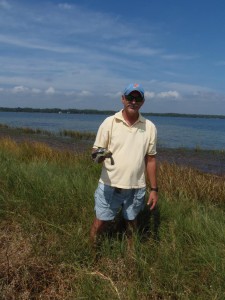
The marshy habitat terrapins love.
Photo: Molly O’Connor
We focused our population surveys to our home counties of Santa Rosa and Escambia counties. We were able to identify 1 nesting beach in Escambia and 2 in Santa Rosa (we have since found a 3rd). We never caught a terrapin in Escambia but had good success at one of the two beaches in Santa Rosa. That population had approximately 50 individuals living within it. From 2007 to 2012 the population remained relatively stable. In 2012 I changed jobs and have not had a chance to re-survey. I plan to do this in 2016.
This year we trained 24 volunteers to assist us in locating and monitoring nesting beaches. They did find a new nesting beach in Santa Rosa and will begin monitoring nesting activity and trapping next year.
These are fascinating creatures and one of the most beautiful turtles you will ever see. Some have asked me about state protection for them. They are listed as a freshwater turtle with FWC thus you cannot possess more than two, cannot have any eggs, and cannot sell them.
If you have questions about diamondback terrapins, are interested in participating in terrapin surveys in Escambia and Santa Rosa counties, or would like to begin your own surveys in your county. Contact me (Rick O’Connor) at roc1@ufl.edu or (850) 475-5230.
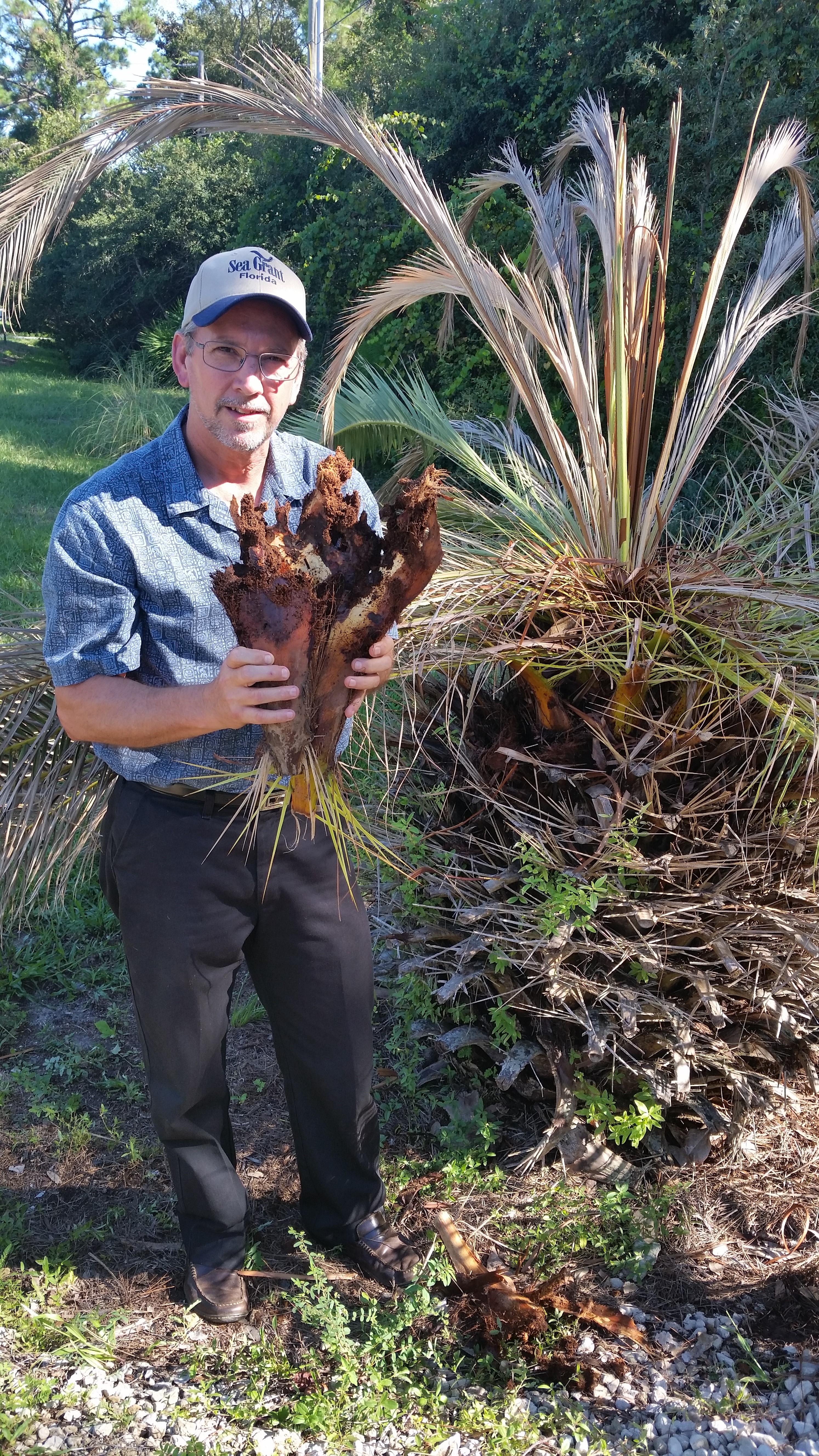
by Erik Lovestrand | Oct 2, 2015
Anyone who has had a treasured palm tree annihilated by palmetto weevils (Rhynchophorus cruentatus) knows the pain of losing a long-lived tree from the home landscape. These large, native weevils are adept at working unnoticed inside a palm to the point of terminal damage. Typically, by the time you notice that the tree is declining and fronds begin to turn brown there is likely no hope of salvaging the situation. By then the larval grubs have already damaged the tree’s growing bud to the point of no return. At this stage the recommended procedure involves removing the tree, cutting it up and burning it to prevent the invading long-snouted critters from moving over to neighboring palms.
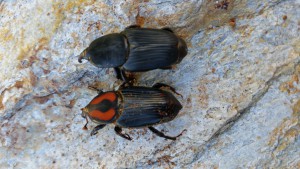
Color and size of adults is quite variable.
However, as frustrating as this is, if we step back and look at the bigger picture it is apparent that even our most aggravating native insect pests are part of the natural web of life and local plants have adapted to survive these “give and take” relationships on the population scale.
Palmetto weevils establish in a new tree when adult females lay their eggs in the crown of the tree and larvae hatch to burrow into the soft terminal bud. It is larval feeding that does the lethal damage. Larvae are large, white, legless grubs that can reach lengths of six-seven centimeters. When larvae are mature they create a cocoon inside the tree from tree fibers and pupate there before hatching into adults to start the cycle over. Grubs can be found in any part of the tree but really need the softer, growing parts for food, such as in the base of the living fronds and the terminal bud.
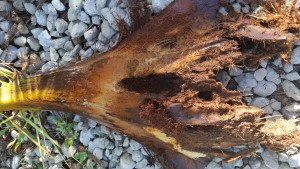
Weevil damage at base of frond.
The condition created by these burrowers is often referred to as “popped neck,” where the top of a palm tree dies and caves over. If you are in the process of removing a dying or dead palm due to the crown dying it would be a good idea cut through the top section with a chainsaw to see if weevil damage is evident in large (about ½ inch) diameter tunnels. If a live specimen of an adult can be captured in a jar it would be worth a visit to your local Extension office for a positive identification to make sure you aren’t dealing with another similar species of non-native weevil that has not been documented in Florida yet. The red palm weevil (Rhynchophorus ferrugineus) has now been found in the U.S. at Laguna Beach, California. Coloration varies by individual bug but a positive i.d. can be obtained by sending the specimen to UF’s laboratory in Gainesville. For further information on palmetto weevils refer to the EDIS fact sheet at this web link.





















